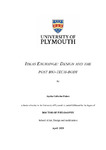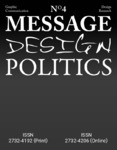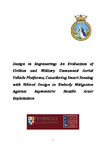Ideas Exchange: Design and the post bio-tech-body
| dc.contributor.supervisor | Punt, Michael | |
| dc.contributor.author | Haines, Agatha | |
| dc.contributor.other | School of Art, Design and Architecture | en_US |
| dc.date.accessioned | 2021-05-05T13:03:35Z | |
| dc.date.available | 2021-05-05T13:03:35Z | |
| dc.date.issued | 2021 | |
| dc.identifier | 10492188 | en_US |
| dc.identifier.uri | http://hdl.handle.net/10026.1/17084 | |
| dc.description.abstract |
This thesis situates speculative design as a valuable tool for thinking about design issues and the body. Bringing together historical, theoretical criticism and practice to show that speculative design is intimately linked with the body. The thesis’ arguments build on the basis that both the body and design have gone through a processes of anatomisation: they have been dissected, separated and segmented into parts and terms. Those parts and terms are then ordered in a fashion which may not necessarily be advantageous intra-disciplinarily, that is for collaborations and discussions within a discipline. A different anatomisation is proposed for more contemporary models of design where the frequent use of relative points of reference is evident, in particular in respect to speculative design. This model in which speculative design is considered as adjunct allows designers to more freely share resources with other disciplines at their converging membranes and through doing so that design itself in these new iterations may be considered a useful investigative instrument for exchanging ideas. Taking a ‘research through design’ approach, the text is informed by a portfolio of practice-based works that reveal the complex continuing relationship between design and the body. The eight original design works made for this thesis present body imaginaries influenced by technological change. The methods used to create the design outputs involved collaborative research and residencies which ultimately advocates the refinement of particular communicative tactics in speculative design. These tactics are outlined as a way to develop a sensibility for myself and those wishing to engage with the current zeitgeist of models of the body and design that may eventually be useful in fostering an ongoing exchange between them so that new forms may evolve in both body and design criticism. | en_US |
| dc.language.iso | en | |
| dc.publisher | University of Plymouth | |
| dc.subject | Design | en_US |
| dc.subject | Speculative design | en_US |
| dc.subject | Body | en_US |
| dc.subject | Bio-tech | en_US |
| dc.subject | Bio art | en_US |
| dc.subject | Bio design | en_US |
| dc.subject | Discursive design | en_US |
| dc.subject | Critical design | en_US |
| dc.subject | Design fiction | en_US |
| dc.subject | Sculpture | en_US |
| dc.subject | Futures | en_US |
| dc.subject | Design futures | en_US |
| dc.subject | Speculation | en_US |
| dc.subject | Medical imaginaries | en_US |
| dc.subject.classification | PhD | en_US |
| dc.title | Ideas Exchange: Design and the post bio-tech-body | en_US |
| dc.type | Thesis | |
| plymouth.version | non-publishable | en_US |
| dc.identifier.doi | http://dx.doi.org/10.24382/564 | |
| dc.identifier.doi | http://dx.doi.org/10.24382/564 | |
| dc.rights.embargoperiod | No embargo | en_US |
| dc.type.qualification | Doctorate | en_US |
| rioxxterms.funder | Plymouth University | en_US |
| rioxxterms.identifier.project | Cognovo | en_US |
| rioxxterms.version | NA |
Files in this item
This item appears in the following Collection(s)
-
01 Research Theses Main Collection
Research Theses Main




